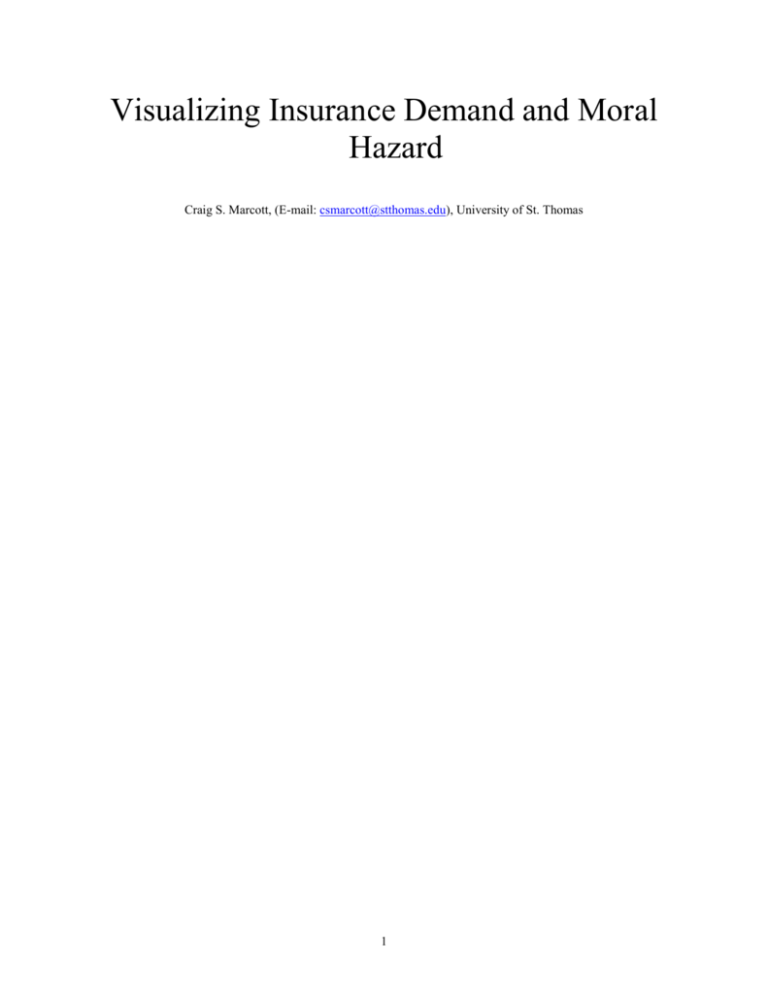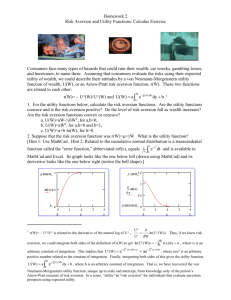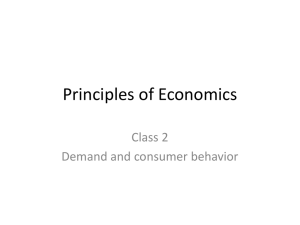Visualizing Insurance Demand and Moral Hazard
advertisement

Visualizing Insurance Demand and Moral Hazard Craig S. Marcott, (E-mail: csmarcott@stthomas.edu), University of St. Thomas 1 Visualizing Insurance Demand and Moral Hazard Abstract This paper presents animated graphical tools linking the Von Neuman-Morgenstern utility theory of consumer choice to the traditional Arrow-Debreu contingent claims approach. By vertically aligning the Von Neuman-Morgenstern expected utility diagram and the budget line-indifference curve diagram this paper allows one to see more clearly how the two approaches are related. A series of animated graphics shows the effects of changing the probability of the hazard, changing the price of insurance and changing the degree of risk aversion. Arrow’s 1963 result that if the insurance contract is actuarially fair a risk averse consumer will always choose to insure fully against the hazard is demonstrated. The robustness of the Arrow result can be evaluated by showing that when the contract has a positive profit the amount of insurance purchased depends on the degree of risk aversion. A graphical construct shows how the demand for insurance is derived. A graphical representation of the moral hazard problem is also presented. JEL categories: D80, D81, D89, A2, A22 Introduction Undergraduate economics courses in price theory present the theory of consumer choice under certainty and uncertainty. For choice under certainty the constructs of indifference curves and budget lines are used to represent consumer choice and demand. Once students gain facility with the simple model, the more general Arrow-Debreu model is introduced in which the consumer derives income from the market value from initial endowments of two goods. This “buying and selling” model is typically presented in different contexts to show labor supply (leisure demand), intertemporal choice (saving and borrowing) and general equilibrium in pure exchange economies. At about the time in the semester when most students become comfortable with the graphical and algebraic tools economists use to describe consumer behavior under certainty instructors throw a wrench in the works by introducing choice under conditions of uncertainty by means of the Von Neuman-Morgenstern model of expected utility. For many students this appears to be a completely different approach to the theory of the consumer choice. Indifference curves and budget lines are no longer used, the consumer choice does not appear in the diagram and probabilities are now used as weights in vector addition. Of course the Von Neuman-Morgenstern model is not a completely different approach to consumer choice. As Debreu explains in chapter 7 of Theory of Value, the theory presented is applicable to decision making under uncertainty upon appropriate interpretation of commodities and markets. Uncertainty is represented with a complete set of forward markets and consumer preferences are defined on a space of lottery tickets (i.e., contingent claims). In this context the Von Neuman-Morgenstern axioms are understood as auxiliary assumptions (i.e., more than what is needed to guarantee the existence of a competitive equilibrium and the two theorems of welfare economics), which give a cardinal representation of utility unique up to a positive affine transformation. This paper links the Arrow-Debreu and Von Neuman-Morgenstern approaches by vertically aligning the diagrams and animating the effects of changes in probabilities, the degree of risk aversion and the price of insurance coverage. Arrow’s 1963 result that if the insurance contract is actuarially fair a risk averse consumer will always choose to insure fully against the hazard is demonstrated by means of animated graphics. The robustness of the result can be evaluated with an animation showing that when the contract has a positive profit the amount of insurance purchased is sensitive on the degree of risk aversion. A new graphical construct shows how the demand for insurance is derived from the two-quadrant construct. Finally, animations are used to show how the consumer equilibrium is affected by the presence of moral hazard. 2 A paper featuring animated graphics naturally loses something when it is presented in static ink and paper. For this reason I have made a Mathematica version of the paper (including code to render the animations) at http://xxxxxx. Animated gifs, which should run in any web browser, are provided for those who are allergic to Mathmatica. Linking the Contingent Claims and Expected Utility Approaches to Choice under Uncertainty Consider an individual who derives utility from consumption in two possible states of nature. In the bad state of nature there is an accident, which occurs with probability B. Let cB = consumption in the bad state of nature (i.e., if the accident occurs) cG = consumption in the good state of nature (i.e., if the accident does not occur) W = the initial endowment of wealth A = the amount of the accident K = the amount of insurance coverage = the price per dollar of insurance (i.e., the premium). The preferences for the consumer are represented with a Von Neuman-Morgenstern utility function u(cB , cG ; B ,1-B ) = B cB + (1-B) cG. The usual expected utility diagram is shown in the upper quadrant of figure one. Figure one is drawn for parameter values B = 0.25, = 0.35, = 0.4. The web version of this paper provides an animation that shows the effects of changing B. The lower quadrant of figure one shows the situation of the consumer in the traditional budget line-indifference curve setting. The budget line pivots through the initial endowment of (W-A, W). In the bad state of nature the consumer has an accident and is left with W-A. In the good state of nature there is no accident and the individual has consumption equal to the wealth of W. The insurance contract allows the consumer to trade Kdollars of consumption in the good state of nature for (1-)K dollars of consumption in the bad state of nature; thus the budget line has a slope of -/(1-). When K dollars of insurance is purchased consumption in the good state of nature is cG = W- Kand consumption in the bad state of nature is cB = W-A+(1-) K. In the context of this insurance problem the budget set has two rationing constraints. First, assuming if the accident does not occur the consumer is better off not buying insurance, the points on the budget line to the left of the endowment are not available. The consumer cannot be a net seller of consumption in the bad state of nature. Second, the consumer cannot choose points on the budget line to the right of the 45-degree line. This means the consumer cannot be more than 100 percent insured. The point of tangency between the budget line and the indifference curve is the consumer equilibrium. Projecting the consumer equilibrium from the lower quadrant up to the upper quadrant links the two diagrams. The equilibrium consumption in the bad state of nature is plotted directly above in the expected utility diagram. The equilibrium consumption in the good state of nature is brought into the upper quadrant by reflecting off the line of full insurance (i.e., the 45-degree line). The quadrants are dynamically linked in the Mathematica version of the paper. The animations show the effects of changing the probability of the hazard, the price of insurance and the degree of risk aversion. 3 Figure 1 Arrow’s Full Insurance Result When = B the insurance contract is actuarially fair in the sense that the expected profit to the insurer is zero. In this case the consumer equilibrium condition of tangency of the indifference curve and budget line requires equality between the marginal utility of consumption in the good and bad states of nature. Assuming the consumer is risk averse (i.e., the Von Neuman-Morgenstern utility function is strictly concave), the equality of marginal utility can occur only if consumption is the same in the good and bad 4 states of nature. Thus the risk averse consumer facing an actuarially fair insurance contract will always choose full insurance. (See Arrow (1963) , or Takayama (1993).) Figure two shows two frames of an animation demonstrating Arrow’s full insurance result. As the insurance premium falls the budget line becomes flatter, pivoting through the initial endowment. The consumer equilibrium moves down the budget line as the consumer purchases more insurance in response to the lower premium. In the right half of figure two the premium has fallen to the value of the probability of the bad state of nature, B. In this case the equilibrium corresponds to full insurance in the sense that consumption is the same in either the good or bad state of nature. Figure 2 While the geometry and algebra of Arrow’s result are easy to understand, the result seems to run counter to intuition. Why doesn’t a person who is extremely risk averse but a lot of insurance and a person who is just barely risk averse buy a small amount of insurance? Both individuals choose full insurance, as is demonstrated in the animation associated with figure three. Here the degree of risk aversion is varied with the utility function parameter . The left half of figure three shows the first frame of the animation (= 0.2) and the right half shows the last frame (= 0.7). As the value of increases the utility function in the upper quadrant becomes less concave and the indifference curves in the lower quadrant become less 5 convex. The point of tangency, however, remains on the 45-degree line; equilibrium occurs at the full insurance point. Figure 3 If the insurance contract has positive expected profit (i.e., > B) the full insurance result no longer holds. Figure four correspond to an animation in which the risk aversion parameter again varies from 0.2 to 0.7. In this case the price of insurance is = 0.4 and the probability of the bad state of nature is B = 0.35. With this “unfair” insurance contract the amount of insurance chosen does depend the degree of risk aversion in the way one would expect. As the consumer becomes less risk averse (i.e., as increases), the point of tangency moves back up the budget line toward the initial endowment. The less risk averse consumer purchases less insurance. Further investigation of this animation reveals that the sensitivity of insurance demand to changes in the risk aversion parameter varies directly with the difference between and B. Specifically, a contract with a large expected profit is very sensitive to the degree of risk aversion. 6 Figure 4 A Graphical Derivation of Insurance Demand The two-quadrant construct described above can be extended to obtain a geometric derivation of insurance demand. Recall that consumption in the bad state of nature is cB = W-A+(1-) K. The consumer starts with wealth of W, suffers a loss of A, pays an insurance premium of K and recovers K from the policy. In figure five a third quadrant is added just below the indifference curve-budget line diagram. Notice that the vertical axis is translated to the right by a distance of W-A. Thus when the equilibrium choice of cB is projected into this third quadrant it is plotted at (1-) K on the horizontal axis. Let 0 denote the price of insurance associated with the budget line and let K 0 denote the corresponding amount of insurance chosen. Next draw a line form the origin of this graph up to the point ( (1- 0) K0, 1- 0 ). This line has a slope of 1/ K0. The point at which the line from the origin through the point ( (1- 0) K0, 1- 0 ) intersects the dotted line plotted at height 1.0 is exactly K 0 from the translated origin of the graph. (Since the line has a slope of 1/ K0, a rise of 1.0 must correspond to a run of K 0.) The two new quadrants on the right simply translate 1- to , and bring the price of insurance into the proper configuration for the demand curve. The demand for insurance curve appears in the lower left quadrant of this five-quadrant contraption. I encourage the reader to view the animated version of this diagram to see the derivation of the insurance demand curve as the price of insurance is varied. 7 Figure 5 8 Visualizing Moral Hazard In the above discussion the probability of the bad state of nature, B, was tacitly assumed to be parametric. When the consumer of insurance can alter the probability that the insurance company will have to pay out on the policy, there is a possibility of moral hazard. Insurance policies typically include provisions for coinsurance or deductibles so that the insured party has an incentive to behave in a way that reduces the likelihood of a loss. Consider a two-period game in which the consumer can exert effort in period one to reduce the probability of ending up in the bad state of nature. This effort can be represented as an inward movement of the initial endowment. The resulting reduction in B takes place in period two of the game. As B decreases the indifference curves become more horizontal and the point of tangency moves up the budget line toward the initial endowment. Here the association with the familiar ArrowDebreu buying and selling model is more difficult. Initial endowments are normally taken as given (rather than chosen as part of an equilibrium), and the equilibrium choice does not ordinarily affect the shape of the indifference map. Figure 6 9 Fortunately, the animated version of the diagram corresponding to figure six handles all of the jockeying around that must be going on inside the consumer’s head. The diagram shows the first and last frames of the animation. As the endowment point moves toward the origin the probability of the bad state of nature falls from 0.33 to 0.2. There are opposing effects that ultimately determine whether the consumer will actually chose to exert the effort to reduce the likelihood of ending up in the bad state of nature. Clearly the inward movement of the initial endowment corresponding to the effort exerted tends to make the consumer worse off. An inward movement of a budget line tends to make the consumer worse off. Concomitantly, there is a reward in expected utility that occurs when B falls and G = 1-B increases. In the computation of expected utility, cB now receives a smaller weight and cG receives a larger weight. (Of course, due to the linkage between the two quadrants of the diagram, both c B and cG are moving targets.) Close inspection of the upper quadrants of figure six reveals that the exertion of effort reduces expected utility. The consumer depicted there would not exert the effort to reduce the probability of the bad state of nature. Altering the parameters—specifically, making B more responsive to the reduction in the endowment—can generate examples where the consumer would choose to exert effort to avoid the hazard. Conclusion Visually linking the traditional budget line-indifference curve and expected utility approaches with animated graphics has several advantages over traditional treatments of choice under uncertainty. Students can see the role that changes in the probability of the hazard play in the consumer equilibrium. In the expected utility diagram the probability of the hazard determines the weights on the consumption vectors in the upper quadrant of the diagram. In the indifference curve-budget line diagram the probability of the hazard affects the shape of the indifference map in the lower quadrant. Dynamically projecting the equilibrium choice back into the expected utility diagram makes the relationship between the two approaches more apparent. Similarly, animations showing how changes in the price of insurance and the degree of risk aversion affect consumer equilibrium help to clarify some of the subtleties of this simple model. Arrow’s full insurance result is particularly striking in this setting; moreover, when the insurance contract has an expected profit the amount of insurance does vary with the degree of risk aversion. With the addition of four more quadrants this graphical construct allows for a straightforward geometric derivation of a demand curve for insurance. When the consumer is a net buyer of consumption in the bad state of nature the demand for insurance is positive. Since options contracts can usually be interpreted as equivalent to purchasing insurance, this construct has the potential to be a visual tool for understanding the pricing of these derivatives. A diagram based on optimizing behavior might someday provide better intuition than a reverse heat equation (Churchill (1963); Black and Scholes (1973)). Finally, animations of the two-quadrant version of the model provide an intriguing way of representing moral hazard. References Arrow, K. J. (1963), “Uncertainty and the Welfare Economics of Medical Care,” American Economic Review 53, 941-973. Black, F. and M. Scholes, “The Pricing of Options and Corporate Liabilities,” The Journal of Political Economy, Vol. 81, No. 3. (May - Jun., 1973), 637-654. Churchill, R. V. , Fourier Series and Boundary Value Problems, 2nd ed. New York: McGraw-Hill, 1963. Debreu, G. (1959), The Theory of Value, New York: John Wiley & Sons, Inc. Takayama, A. (1993), Analytical Methods in Economics, Ann Arbor: University of Michigan Press. 10 11






